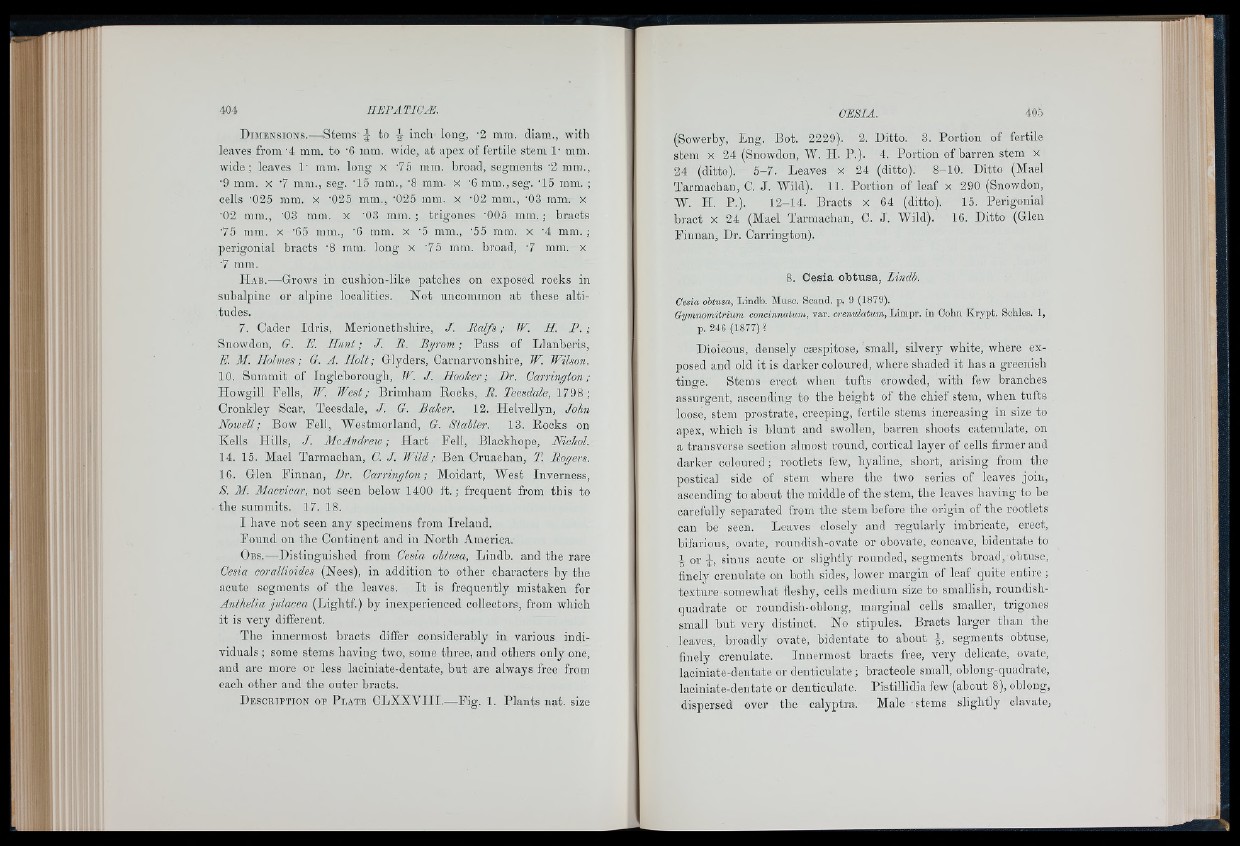
Dimensions.— Stems'-J to -J- inch long, -2 mm. diam., with
leaves from '4 mm. to 'G mm. wide, at apex of fertile stem 1- mm.
wide; leaves 1' mm. long x '75 mm. broad, segments '2 mm.,
•9 mm. X '7 mm., seg. '15 mm., '8 ram. x '6 mm., seg. '15 mm. ;
cells '025 mm. x '025 mm., '025 mm. x '02 mm., '03 mm. x
•02 mm., '03 mm. x '03 mni. ; trigones '005 mm. ; bracts
•75 mm. X '65 mm., '6 mm. x '5 mm., '55 mm. x '4 mm. ;
perigonial braots '8 mm. long x '75 mm. broad, '7 mm. x
•7 mm.
H ab.—Grows in eusbion-like patches on exposed rocks in
subalpine or alpine localities. N o t uncommon a t these a ltitudes.
7. Cader Idris, Merionethshire, J. B a lfs; TF. II. P. ;
Snowdon, G. P. H u n t; J. B. Byrom; Pass of Llanberis,
E. M. Holmes; G. A. Holt; Glyders, Carnarvonshire, TF. Wilson.
10. Summit of Ingleborough, TF. J. Hooker; Er. Carrington;
Howgill Fells, TF TVest; Brimham Rooks, B. Teesdale, 1798;
Cronkley Scar, Teesdale, J. G. Baker. 12. Helvellyn, John
Nowell; Bow Fell, Westmorland, G. Stabler. 13. Rooks on
Kells Hills, J. IIcAndreio; Hart Fell, Blackhope, Nichol.
14. 15. Mael Tarmachan, C. J. TFild; Ben Cruachan, T. Bogers.
16. Glen Finnan, Er. Carrington; Moidart, West Inverness,
8. M. Macvicar, not seen below 1400 f t .; frequent from this to
the summits. 17. 18.
I have not seen any specimens from Ireland.
Found on the Continent and in North America.
O bs.—Distinguished from Cesia obtusa, Lindb. and the rare
Cesia corallioides (Nees), in addition to other charaoters by tbe
acute segments of the leaves. I t is frequently mistaken for
Anthelia julacea (Lightf.) by inexperienced collectors, from which
it is very different.
The innermost bracts differ considerably in various individuals
; some stems having two, some three, and others only one,
and are more or less laciniate-dentate, but are always free from
each other and the outer bracts.
D e s c r i p t i o n o e P l a t e CLXXVIII,— Pig. 1. Plants nat. size
(Sowerby, Eng. Bot. 2229). 2. Ditto. 3. Portion of fertile
stem x 24 (Snowdon, W. H. P.). 4. Portion of barren stem x
24 (ditto). 5-7. Leaves x 24 (ditto). 8-10. Ditto (Mael
Tarmachan, C. J. Wild). 11. Portion of leaf x 290 (Snowdon,
W. H. P.). 12-14. Braots x 64 (ditto). 15, Perigonial
bract x 24 (Mael Tarmachan, C. J. Wild). 16. Ditto (Glen
Einnan, Dr. Carrington).
8. Cesia obtusa, lindb.
Cesia obtusa, Lindb. Muse. Scand. p. 9 (1879).
Gymnomitrium concinnatum, var. cremMΣ(i«m, L impr. in Cohn K ry p t. Schles. 1,
p. 24G (1877)?
Dioicous, densely cæspitose, small, silvery white, where exposed
and old it is darker coloured, where shaded it has a greenish
tinge. Stems erect when tufts crowded, with few branches
assurgent, ascending to the height of the chief stem, when tufts
loose, stem prostrate, creeping, fertile stems increasing in size to
apex, which is blunt and swollen, barren shoots catenulate, on
a transverse section almost round, cortical layer of cells firmer and
darker coloured ; rootlets few, hyaline, short, arising from the
postical side of stem wliere the two series of leaves join,
ascending to about the middle of the stem, the leaves having to be
carefully separated from the stem before the origin of the rootlets
can he seen. Leaves closely and regularly imbrioate, erect,
bifarious, ovate, roundish-ovate or obovate, concave, bidentate to
I or g, sinus acute or slightly rounded, segments broad, obtuse,
finely crenulate on both sides, lower margin of leaf quite entire ;
texture somewhat fleshy, cells medium size to smallish, roundish-
quadrate or roundish-oblong, marginal cells smaller, trigones
small hut very distinct. No stipules. Braots larger than the
leaves, broadly ovate, bideniate to about J, segments obtuse,
finely crenulate. Innermost bracts free, very delicate, ovate,
laciniate-dentate or denticulate ; bracteole small, oblong-quadrate,
laciniate-dentate or denticulate. Pistillidia few (about 8), oblong,
dispersed over the calyptra. Male stems slightly clavate,